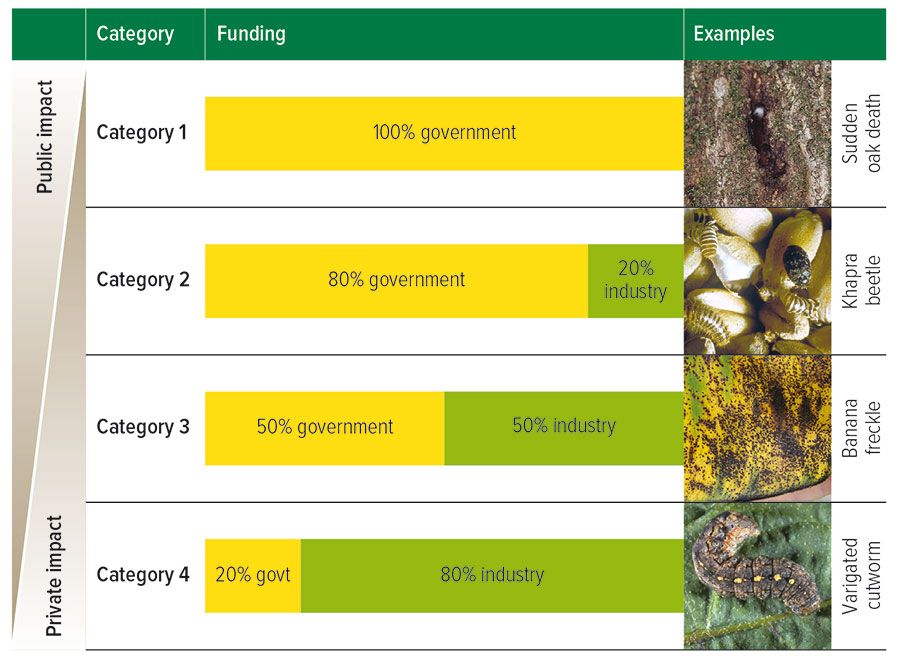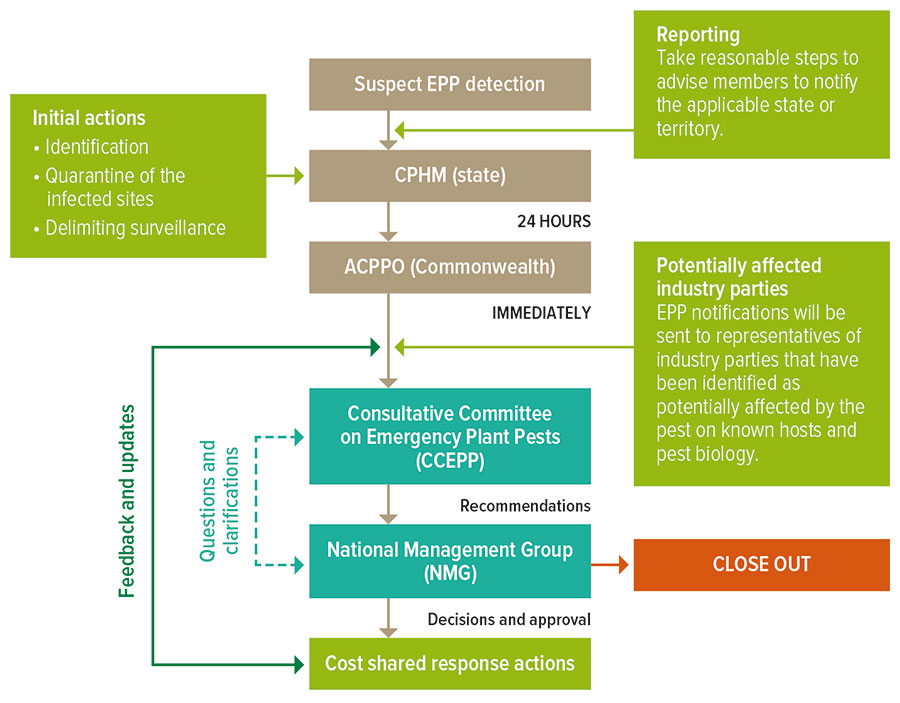Have you ever wondered what goes on behind the scenes of biosecurity when a new pest is found in Australia?
Plant pests yet to appear in Australia are called exotic plant pests, also known as emergency plant pests or EPPs for short. These come knocking on Australia’s door from time to time and, occasionally, one may gain entry. A recent example would be fall armyworm, which was detected in Australia in February 2020.
In anticipation of plant pest incursions, an Emergency Plant Pest Response Deed (EPPRD) – commonly known as the ‘Deed’ – was negotiated by Australian governments, plant industry organisations and Plant Health Australia (PHA) over several years, coming into effect in 2005. PHA is the custodian of the Deed and collaborates with signatories to keep it contemporary and support its implementation.
Categorising the threat
Under the Deed, EPPs are classified into four categories (see Figure 1) and these are captured in Schedule 13 of the Deed. Currently, there are no EPPs in Category 1 that affect the grains industry.

Pest categories of the Emergency Plant Pest Response Deed (EPPRD). Source: PHA
Classification is based on the public/private benefit of eradication of the EPP, with the distinction used to decide how costs are shared between the governments (federal, state and territory) and the affected plant industries.
Should there be a funded response to an uncategorised plant pest believed to be an EPP, then the ‘default’ category is applied pending categorisation. Category 1 EPPs have high environmental or human health impacts, so governments share the costs among themselves, while for Category 4 pests, industry as the primary beneficiary picks up the majority of the costs.
The system is intended to act as an insurance policy for the plant industries. It provides funds through a predetermined cost-sharing arrangement, makes resources available with minimal delay, provides the necessary support structures within governments and an agreed plan of action with industry.
A staged response
Time is of the essence when a suspected EPP is discovered. The sooner a suspected EPP is reported, the faster it can be identified and, hopefully, successfully eradicated. The key steps taken to manage an incursion are shown in Figure 2. The Exotic Plant Pest hotline (1800 084 881) should be used to report suspect plant pests.

Overview of the exotic plant pests (EPPs) response management plan and procedures. Source: PHA
The hotline will alert specialist diagnosticians in the relevant state or territory to inspect samples and identify the pest and determine if this is an EPP. If it is an EPP, the expert will inform the state/territory chief plant health officer, who will inform the Australian chief plant protection officer (ACPPO).
Once a suspected EPP is reported to the ACPPO, the affected parties from government and industry, who are signatories to the Deed, and PHA will be notified. The ACCPO will convene a meeting of the Consultative Committee on Emergency Plant Pests (CCEPP).
If both the potential spread and impact of the pest are considered potentially serious, then the relevant state or territory agriculture department may adopt precautionary measures where the pest was found. Depending on the pest, these might include interim control or containment measures such as:
- restriction of operations in the area;
- removing people, vehicles and machinery from the area to conduct disinfection; and
- restricted access to the area.
The lead agency will develop a response plan and present it to the CCEPP. The CCEPP will make a recommendation to the National Management Group (NMG) based on the EPP status and feasibility of eradication. The NMP may approve a response plan and national cost-sharing arrangements to fund the response.
To determine the feasibility of eradication, the CCEPP considers:
- the technical feasibility, including the likelihood of a successful eradication; and
- the cost–benefit of eradication.
During the investigation and alert phase, the affected area may be placed under quarantine or pest control notices issued until a decision is made by the NMG on whether to eradicate or control the pest. Efforts then enter the operational phase until eradication has been achieved or a transition to management is required.
Acronyms
ACCPO – Australian chief plant protection officer
CCEPP – Consultative Committee on Emergency Plant Pests
CPHM – chief plant health manager
EPP – exotic plant pest
EPPRD – Emergency Plant Pest Response Deed
NMG – National Management Group
More information: Jeff Russell, jeff.russell@dpird.wa.gov.au; Plant Health Australia - Emergency plant pest response deed.

























































